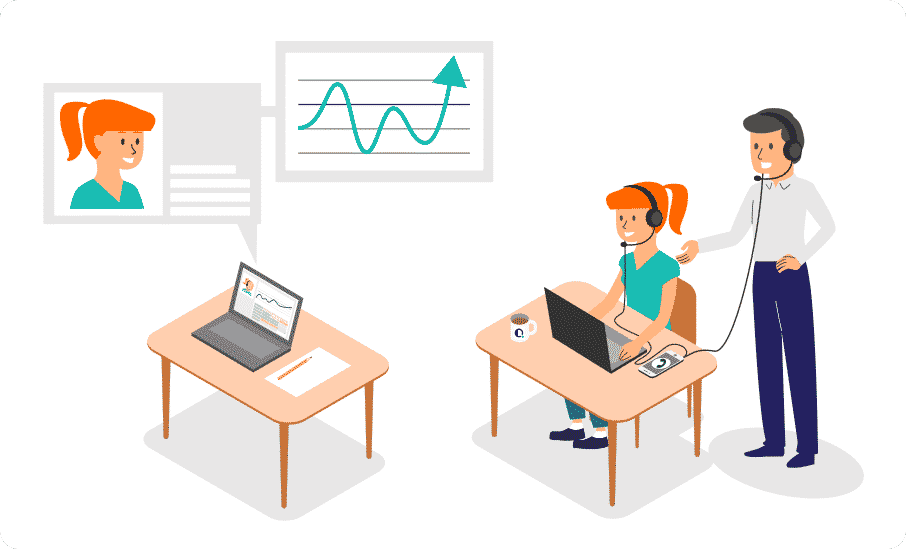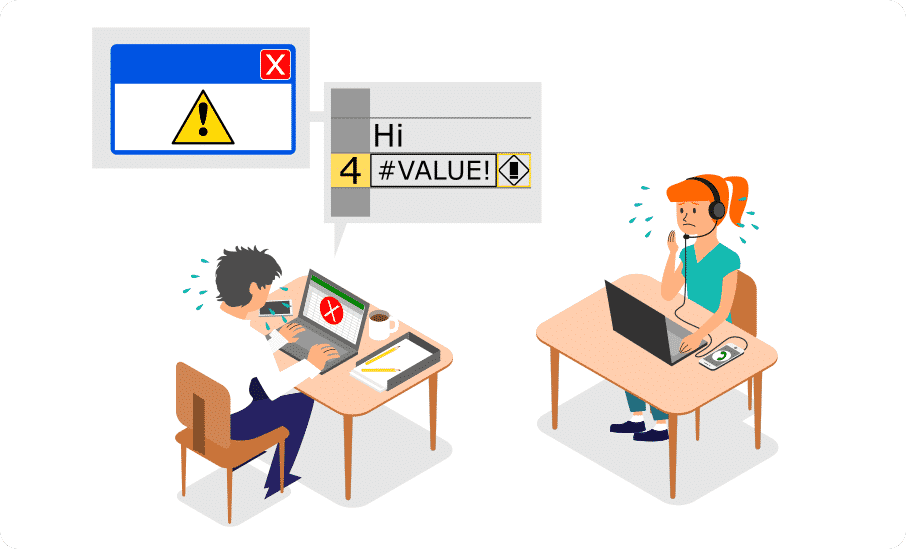QualityDesk and Puzzel have agreed on an integration partnership that allows contact centers to carry out quality assurance easily, fluently and systematically.
Many contact centers even today still rely on Excel or other similar tools for quality assurance. These tools are tricky to use and rarely provide a full picture of quality or the current situation employees, teams and units in terms of quality and its development.
QualityDesk is an online quality assurance software that allows you to build monitoring forms directly in the software within minutes and start filling in evaluations of the contact center’s interactions. Real-time reports describe the current situation and the development and trend to help predict contact handle times, among other things
Together with Puzzel, we provide an integration where you can quickly see customer service agents’ recorded calls, chat contacts, tickets etc. and simply click on a button to start an evaluation. This means that searching for and saving recordings and producing evaluations in a separate software is history, allowing organizations to once again save hundreds of hours every month.
Quality assurance in customer service – what and how?
The purpose of quality assurance is to measure actions to help identify what is actually done in customer interactions, what is not done and what is done right or wrong.
Quality assurance is the principal measure for reaching numerical targets. If a contact center wishes to, for example, achieve a certain contact handle time, it is important to know what actually happens in customer interactions.
On the other hand, it is also important to know how the targets can be achieved. If the goal is to reduce handle times, what does this mean in practice? The only way to find out is to systematically listen to interactions and assess the quality of operations.
The easiest way to conduct quality assurance is to use a clear evaluation form where you can identify the various elements of an interaction and the practical measures under each element. For example, to achieve more efficient handle times, one of the objects of evaluation on the form could be “Does the customer service agent politely interrupt the customer when necessary?” or “The customer service agent tells the customer what will be discussed during the call” etc.
Feedback should always be given and discussions held with customer service agents to make sure that they have a clear understanding of the link between actions and numerical targets. It is a good idea to also include brief explanations of each object of evaluation in the form. This way, everyone will be clear on why something is being evaluated and why it is significant.
Quality assurance should be regular and systematic
Quality should be assured regularly to obtain enough data on actions to coach customer service agents. The measure should be an everyday thing and, in many respects, it should be defined as the single most important measure.
The problem typically lies in the small number of quality assessments. Many are under the impression that they are done only because they have to be done, but their significance is not fully understood. The reason for this is often a lack of proper tools. Using separate Excel files is far from ideal, and the full picture is never quite clear.
If this is the case, the key is to make sure that everyone working at the contact center understands the significance of quality assurance and sets goals for the number of evaluations. A good goal is usually 4 evaluations per agent per month. This already produces enough information to coach the agent. When evaluations are conducted regularly, this amount also provides insight into the development of the customer service agent’s quality.

Measuring customer experience to support quality assurance
Unfortunately, the situation is often quite the opposite. Customer experience is measured regularly, but quality assurance is neglected or is only done based on negative feedback. This is entirely the wrong approach.
Measuring customer experience does not necessarily tell you very much. If you measure it without knowing what the goals for customer interactions are, it is extremely difficult to understand the reasons behind the feedback from customers. You can easily therefore end up in a situation where only a few people, if any, at the contact center understand what they have done right in terms of positive feedback and where things have gone wrong in terms of negative feedback. In these situations, you often come across the phrase “We can’t help it if things don’t work somewhere else in our company.” Customer service agents can always turn an experience from bad to excellent.
However, it is important to know the goals for customer interactions on a practical level to deliver more even quality to customers. If the goals are not clear to everyone, the customer experience can be poor or the results of its measurement may mislead the company.
For example, if the goal of customer service is to drive additional sales, this usually requires a survey of the customer’s overall situation and selling more. If agent A does not like this and only deals with the customer’s issue, listens to the customer’s stories and finally wishes them all the best, agent A can earn top scores, 10/10 for their performance.
Agent B takes the instructions seriously and understands the significance of additional sales targets. When the customer who previously called A now calls B, agent B politely interrupts them when they go off topic, conducts a full survey of the situation and offers additional sales to the customer as instructed. The customer can see this as poor service compared to the other agent and therefore gives a rating of 6/10.
Now when the supervisors listen to the recordings of negative interactions, they struggle to understand why a perfectly good interaction received such a poor rating. On the other hand, in a worst-case scenario the supervisors will consequently no longer demand agent compliance with the instructions in the future.
Due to this, it is important that contact centers have internal quality indicators to guarantee even quality and only then start to measure the customer experience.
How does quality assurance help with peak times?
Quality assurance helps with peak times, because it is systematic. In practice, this means that when actions are systematically monitored and developed based on feedback to reach the desired outcomes, handle times can be anticipated more accurately.
Resourcing therefore also becomes automatically easier when you can count on the target handle times to hold up.
If the handle times vary depending on the customer service agent, resourcing can never be very accurate and therefore the labor resources can end up being too low, even if peak times could have been anticipated in advance.
Create clear approaches for unexpected peak times
A good way to deal with peak times is to create a clear contact handling approach for busy times. In practice, this could mean leaving all the extra things out from customer interactions.
Agents focus on dealing with the acute situation with customers and leave everything else out. Friendliness and understanding the customer’s situation should naturally be present in all situations.
During peak times, interactions should be straightforward, as this alone will speed up customer service and reduce queues.
Do not neglect quality assurance during peak times, agents need support!
Many customer service providers also ask the supervisors and coaches to handle interactions during peak times. This may of course be necessary in some circumstances, but you should always make sure that supervisors also have time to support their team.
During peak times, customers often have to wait longer, meaning that they are already angry or frustrated when the call gets through. When a customer service agent has to deal with dozens, even hundreds of angry customers in one day, they can quickly start to feel discouraged.
This easily leaves them feeling bad, which also reflects on the customers. When both the agent and the customer are in a bad mood to start with, it is not hard to guess what will happen.
It is therefore extremely important that supervisors support customer service agents also during peak times. They can listen in to calls and give feedback and encouragement during peak times.
If the call center has a peak time approach, it is particularly important that team leaders go through the approach with every agent, when needed, or at least let them know when the approach is applied.
TOP 5 quality assurance tips
- 1. Create a clear evaluation form based on the goals of the contact center.
If your goal is additional sales, for example, think of ways to drive sales. After this, add the elements that drive sales in practice on the evaluation form. If you know customer service agents who handle contacts the way you would want everyone to handle them, listen to what they have to say and draw up the evaluation form with them. After this, you should go through the evaluation form with everyone in one-on-one or team coaching sessions. This allows you to disseminate good approaches to everyone quickly and easily, and everyone is clear on what is expected of their interactions with customers.
- 2. Make sure the evaluation form is in line with your targets.
Be careful with numerical targets and performance targets. This means that if the contact handle time is, say, 2 minutes, there may not necessarily be time to do much, such as a full survey of the situation, additional sales, advice and guidance. A contact center may have 50 customer service agents, of whom 10 drive additional sales with a contact handle time of 7 minutes. The other 40 agents do not focus on additional sales and their handle time is 3 minutes. If you can get these 40 agents to pursue additional sales, their handle time will become much longer, meaning that you may need to hire more customer service resources.
- 3. Set a goal for the number of evaluations.
It is important that you set quantitative goals for the number of evaluations: how many evaluations per month. If goals are not set, it is likely that the evaluations will not get done. If no data on performance is collected, you will have to guess what causes what and adjust activities based on nothing. Goals also need to be monitored and their achievement should be expected. This way, you can ensure that the contact center has sufficient data for coaching customer service agents.
- 4. Let customer service agents evaluate themselves and make time for this.
It is a good idea to let customer service agents conduct regular self-evaluations. This may be tricky in terms of resourcing, but it is not impossible. Self-evaluation times can be scheduled during quieter moments, or you can take advantage of any unexpected quiet moments. If the wait times are long, ask the customer service agents to conduct evaluations. This gives you even more data on performance and you can also enable the personal development of agents. Self-evaluations also help you clarify the goals and expectations for customer interactions. This speeds up learning.
- 5. Calibrate the evaluation form regularly.
The evaluation form should be calibrated regularly through joint listening sessions. This should be done at least with the supervisors. In practice, you choose 3–5 interactions that are evaluated by everyone and compare the results. The team can then discuss any differences and synchronize their understanding of the objects of evaluation and their views. This should also be done with customer service agents during team coaching sessions, for example.
Quality assurance has a significant effect on many things!
Quality assurance should therefore not be buried under other work, but rather made the first priority. It is the most important measure that affects a large number of things in a contact center. These include additional sales, customer experience, resourcing, employee satisfaction, understanding goals, understanding expectations, understanding instructions and reaching targets in general.
If you want to find out how we can help you, I would be happy to tell you more! I can give you a concrete demonstration of how our software can help you put all the things mentioned here in order with little effort and only a couple hours of work. You can book a meeting below 👇👇




